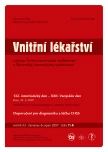Differential diagnosing of hypercalcemias
Authors:
P. Broulík
Authors‘ workplace:
III. interní klinika 1. lékařské fakulty UK a VFN Praha, přednosta prof. MUDr. Štěpán Svačina, DrSc., MBA
Published in:
Vnitř Lék 2007; 53(7-8): 826-830
Category:
Overview
Primary hyperparathyreosis and tumour diseases are the two most frequent causes of hypercalcaemia. Surgical removal of parathyroid adenoma is the permanent solution for hypercalcaemia. Hypercalcaemia may occur in 20–30 % of patients with cancer in the course of the disease. It causes progressive deterioration of the overall condition of the patient which culminates in a coma-like state with renal failure and means a bad prognosis for the affected person. Evaluation of clinical condition and obtaining the immunoreactive parathormone level data are of extreme importance for correct diagnosis. Normal or even low parathormone levels almost surely exclude primary hyperparathyreosis as the source of hypercalcaemia. Additional, less frequent causes of hypercalcaemia should also be taken into consideration, such as diseases caused by the granulomatose tissue, familial benign hypocalciuric hypercalcaemia, drug provoked hypercalcaemia, high thyroid hormone doses and patient dehydration. Fast replenishment of liquids and administration of bisphosphonates are the cornerstones of hypercalcaemia therapy.
Key words:
hypercalcaemia – primary hyperparathyreosis – tumour disease hypercalcaemia – parathormone – bisphosphonates
Sources
1. Stewart AF. Hypercalcemia associated with cancer. N Engl J Med 2005; 352: 373-379
2. Ranco C, Bellomo R. Critical Care Nephrology. Boston: Kluwer Academic Publishers 1998; 211-223.
3. Broulík P. Poruchy kalciofosfátového metabolismu. Praha: Grada a Avicenum 2003.
4. Clezardin P, Fournier P, Bossier S et al. In vitro and in vivo antitumor effects of Bisphosphonates. Curr Med Chem 2003; 10: 173-180.
5. Broulik P, Adámek S, Libánský P et al. Diagnostika a léčba primární hyperparatyreózy. Interní medicina pro praxi 2007; 3: 130-132.
6. Pecherstofer M, Brenner K, Zojer N. Current management strategies for hypercalcemia. Treat Endocrinol 2003; 2: 273-292.
7. Goltzmann D. Osteolysis and cancer. J Clin Invest 2001; 107: 1219-1220.
8. Ziegler R. Hypercalcemis crisis. J Am Soc Nephrol 2001; 12(Suppl 17): S3-S9.
9. Favus MJ (ed). Primer on the Metabolic Bone Diseases and disorders of mineral metabolism. 6th ed. Philadelphia: Lippincott Williams&Wilkins 2006.
10. Jacobs TP, Bilezikian JP. Clinical review: Rare causes of hypercalcemia. J Clin Endocrinolog Metab 2005; 90: 6316-6326.
Labels
Diabetology Endocrinology Internal medicineArticle was published in
Internal Medicine

2007 Issue 7-8
Most read in this issue
- Hypopituitarism – substitution therapy
- Autoimmune polyglandular syndromes: clinical aspects
- Aspiration cytology of the thyroid
- Randomly discovered enlargement in the region of sella turcica
